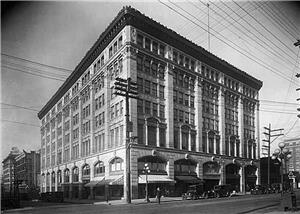On September 6, 1996, ACT (A Contemporary Theatre) stages Cheap, the first show in its new $30.4 million complex, Kreielsheimer Place, in downtown Seattle. Seattle Times theater critic Misha Berson writes that the show "looks grand in its new surroundings" (Berson, "Star"). The extensively renovated former Eagles Auditorium includes three new performing spaces. This comedy farce is staged in the Gregory A. Falls Theatre, named after ACT's ailing founder. Berson calls the configuration of the new stage "strikingly similar" to ACT's former Queen Anne home, with the same kind of thrust stage (with seating on three sides), yet with better sightlines and décor (Berson, "Star"). The play itself is a loose adaptation by Tom Topor of Moliere's "The Miser," and is dismissed by Berson as "amiable but unremarkable" (Berson, "Star") and by the Seattle Post-Intelligencer's Joe Adcock as "frothy" and "mildly stimulating" (Adcock). Yet ACT soon hits its stride and the new venue helps to revitalize downtown Seattle's arts scene.
For Theater and For Downtown
ACT had been seeking a new building for more than a decade. ACT's original theater, since its founding in the summer of 1965, was in the former Queen Anne Hall at the foot of Queen Anne Hill at 1st Avenue and Roy Street. This intimate thrust-stage theater had served ACT well -- the theater had grown into one of Seattle's top cultural institutions. Yet it had little backstage space or shop space, the seating was cramped, and the roof leaked. The ACT board had considered other downtown locations when it learned that the old Eagles Auditorium at 700 Union Street was available.
The auditorium had been constructed by the Fraternal Order of Eagles (an organization founded in 1896 by a group of Seattle theater managers) and opened in 1925. It was designed by Seattle architect Henry Bittman (1882-1953), and was one of the finest and best preserved examples of architectural terra-cotta in Seattle. The building was prominently sited in the central business district at the northeast corner of the intersection of Seventh Avenue and Union Street. In active use by the Eagles until 1981, as a rental facility it hosted many memorable light show/dance events known as Trips Festivals during the late 1960s and early 1970s. The building was on the National Register of Historic Places and was a designated City of Seattle landmark, but was run-down and would require extensive renovation -- and a huge capital fundraising campaign.
Philip Condit, president of The Boeing Co., and a longtime ACT supporter and board member, spearheaded the drive. The goal was enormous -- $30.4 million -- yet by March 1996 the theater had already raised $25.3 million and would soon meet its goal with help from major grants from The Boeing Co., The Allen Foundation, Microsoft Corporation, the William H. Gates Foundation, SAFECO Insurance, Priscilla "Patsy" Collins, and the Kresge Foundation, along with public funds from the City of Seattle, King County and the state. The Kreielsheimer Foundation stepped in with two major grants, which ensured that the entire complex would be named Kreielsheimer Place.
The entire project was a mix of what Berson called "careful planning and enthusiastic community support" (Berson, "ACT Makes"). The project's backers saw it not only as a new theater project, but also as a downtown revitalization project. The complex also included 44 affordable apartments.
Intimate But Elegant
ACT turned the old auditorium into three separate performing spaces: a 409-seat thrust-stage theater named the Falls Theatre, named after ACT founder Gregory Falls (1922-1997); a 434-seat in-the-round space called the Allen Theatre; and a 150-seat cabaret theater called the Bullitt Cabaret. Visitors touring the space during the official ribbon-cutting ceremony at noon on September 6, 1996, gave it boffo reviews.
"What I like is that it actually feels like the old place," said visitor Gary Tucker. "The same seating, the same intimacy, but it's also elegant" (De Leon).
The first production, Cheap, a loose adaptation of Moliere's The Miser, took place that night in the Falls Theatre. Artistic director Peggy Shannon said she chose this "door-slamming farce" to inaugurate the theater because she wanted "something, up, positive and fun" and "something families could go to" (Berson, "For Opening Night").
ACT threw a gala party on September 8, 1996, complete with live bands and speeches. During that event, Condit said "one of the reasons I've been so involved is because the city needs a vital downtown, and this is a wonderful piece of that" (Berson, "ACT Throws").
The new ACT theater went on to fulfill those hopes. It continues to be a key component of the Seattle downtown arts district.

